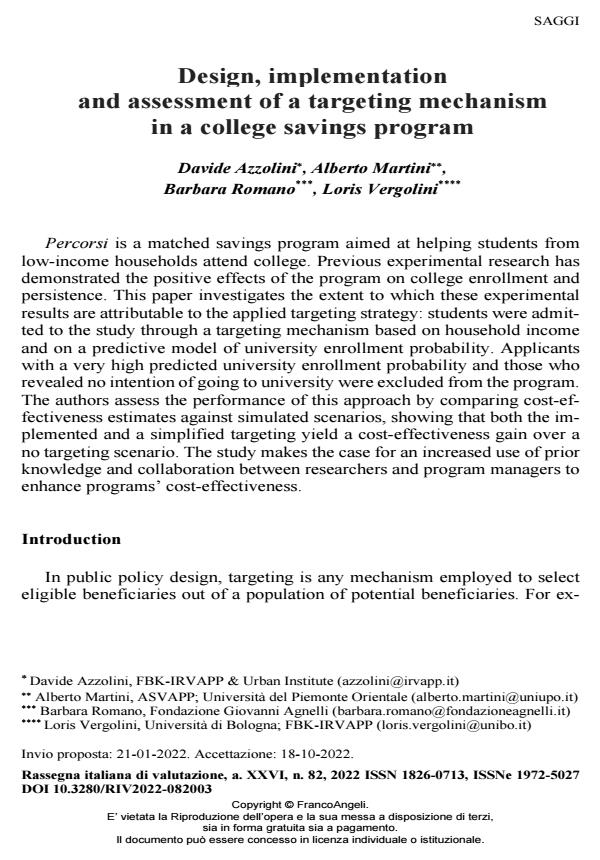Design, implementation and assessment of a targeting mechanism in a college savings program
Titolo Rivista RIV Rassegna Italiana di Valutazione
Autori/Curatori Davide Azzolini, Alberto Martini, Barbara Romano, Loris Vergolini
Anno di pubblicazione 2023 Fascicolo 2022/82
Lingua Inglese Numero pagine 21 P. 33-53 Dimensione file 460 KB
DOI 10.3280/RIV2022-082003
Il DOI è il codice a barre della proprietà intellettuale: per saperne di più
clicca qui
Qui sotto puoi vedere in anteprima la prima pagina di questo articolo.
Se questo articolo ti interessa, lo puoi acquistare (e scaricare in formato pdf) seguendo le facili indicazioni per acquistare il download credit. Acquista Download Credits per scaricare questo Articolo in formato PDF

FrancoAngeli è membro della Publishers International Linking Association, Inc (PILA)associazione indipendente e non profit per facilitare (attraverso i servizi tecnologici implementati da CrossRef.org) l’accesso degli studiosi ai contenuti digitali nelle pubblicazioni professionali e scientifiche
Percorsi is a matched savings program aimed at helping students from low-income households attend college. Previous experimental re-search has demonstrated the positive effects of the program on college enrollment and persistence. This paper investigates the extent to which these experimental results are attributable to the applied targeting strategy: students were admitted to the study through a targeting mechanism based on household income and on a predictive model of university enrollment probability. Applicants with a very high predicted universi-ty enrollment probability and those who revealed no intention of going to university were excluded from the program. The authors assess the performance of this approach by comparing cost-effectiveness esti-mates against simulated scenarios, showing that both the implemented and a simplified targeting yield a cost-effectiveness gain over a no tar-geting scenario. The study makes the case for an increased use of prior knowledge and collaboration between researchers and program manag-ers to enhance programs’ cost-effectiveness.
- Aber, J.L., Morris, P., Wolf, S., Berg, J. (2016). The impact of a holistic conditional cash transfer program in New York City on parental financial investment, student time use, and educational processes and outcomes. Journal of Research on Educational Effectiveness, 9(3): 334-363
- Azevedo, V., Robles, M. (2013). Multidimensional targeting: Identifying beneficiaries of conditional cash transfer programs. Social Indicators Research, 112(2): 447-475.
- Bloom H.S. (2008). The Core Analytics of Randomized Experiments for Social Research. In: Alasuutari P., Bickman L., Brannen J., editor, The SAGE Handbook of Social Research Methods. Thousand Oaks, CA: Sage Publications.
- Coady D., Grosh M.E., Hoddinott J. (2004). Targeting of Transfers in Developing Countries: Review of Lessons and Experience. Washington DC: World Bank.
- Coady, D.P., Parker, S.W. (2009). Targeting performance under self-selection and administrative targeting methods. Economic Development and Cultural Change, 57(3): 559-587.
- Deming, D., Dynarski, S. (2010). College aid. In: Levine P.B., Zimmerman D.J., editor, Targeting investments in children: Fighting poverty when resources are limited. Chicago: University of Chicago Press.
- De Janvry, A., Sadoulet, E. (2006). Making conditional cash transfer programs more efficient: designing for maximum effect of the conditionality. The World Bank Economic Review, 20(1), 1-29.
- Devereux, S., Masset, E., Sabates-Wheeler, R., Samson, M., Rivas, A.M., Te Lintelo, D. (2017). The targeting effectiveness of social transfers. Journal of Development Effectiveness, 9(2): 162-211.
- Elbers C., Fujii T., Lanjouw P., Ozler B., Yin W. (2007). Poverty alleviation through geo-graphic targeting: How much does disaggregation help? Journal of Development Economics, 83: 198-213.
- Erikson, R., Goldthorpe, J. H. (2002). Intergenerational inequality: A sociological perspective. Journal of Economic Perspectives, 16(3), 31-44.
- Grosh, M. (1994). Administering Targeted Social Programs in Latin America: From Platitudes to Practice. Washington D.C.: World Bank.
- Martini A. (2014). Valutare l’impatto degli incentivi monetari condizionati: esperimento classico o selezione mirata dei beneficiari? “Paper presentato alla conferenza Espanet Sfide alla cittadinanza e trasformazione dei corsi di vita”, Torino, 18-20 settembre.
- Martini, A., Azzolini, D., Romano, B., Vergolini, L. (2021). Increasing college going by incentivizing savings: Evidence from a randomized controlled trial in Italy. Journal of Policy Analysis and Management, 40(3): 814-840.
- Orfield, G. (2002). Foreward. In: Heller D.E., Marin P., editor, Why should we help? The negative social consequences of merit aid scholarships. Cambridge (MA): Civil Rights Project, Harvard University.
- Rawlings, L.B., Rubio, G.M. (2005). Evaluating the impact of conditional cash transfer programs. The World Bank Research Observer, 20(1): 29-55.
- Sherraden, M., 1991. Assets and the Poor: A New American Welfare Policy. Armonk, NY: ME Sharpe.
- Schreiner, M., Ng, G.T., Sherraden, M. (2006). Cost-effectiveness in individual development accounts. Research on Social Work Practice, 16(1): 28-37.
- Ssewamala, F.M., Wang, J.S. H., Neilands, T.B., Bermudez, L. G., Garfinkel, I., Waldfogel, J., et al. (2018). Cost-effectiveness of a savings-led economic empowerment intervention for AIDS-affected adolescents in Uganda: Implications for scale-up in low-resource communities. Journal of Adolescent Health, 62(1): S29-S36.
- van Oorschot W. (2001). Troublesome Targeting: On the Multilevel Causes of Non take-up. In: Ben-Arieh A., Gal J., editor, Into the Promised Land: Issues Facing the Welfare State. Westport (CT): Preager Publishers.
- Vergolini, L., Zanini, N. (2013). Designing effective educational policies: what can we learn from an Italian case study. Educational Research and Evaluation, 19(5): 426-441.
- Vergolini, L., Zanini, N. (2015). Away, but not too far from home. The effects of financial aid on university enrollment decisions. Economics of Education Review, 49: 91-109.
Davide Azzolini, Alberto Martini, Barbara Romano, Loris Vergolini, Design, implementation and assessment of a targeting mechanism in a college savings program in "RIV Rassegna Italiana di Valutazione" 82/2022, pp 33-53, DOI: 10.3280/RIV2022-082003